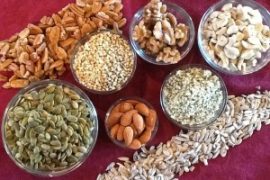Butternut squash is one of my favorite fall and winter vegetables. Butternut squash is low in calories, rich in fiber and phyto nutrients. Foods rich in vitamin A such as butternut squash also help protect the body against lung and oral cavity cancers.
Almost all parts of the squash are edible; “meat”, flowers and seeds included. Flowers can be stuffed or added to soups, seeds can be roasted or saved to regrow, and the “meat” is incredibly versatile. Butternut squash can be used as a filling for ravioli, roasted as a side dish, spiralized raw for salads, and used in lasagnas, soups, made into fries or risotto. You can even mix cooled, roasted butternut squash with coconut milk and some ginger and cinnamon for an amazing smoothie.
Due to its amazing nutritional benefits and versatility, this is one vegetable that is worth having in your pantry.
Health Benefits (1, 2, 3, 4, 5)
• One cup of butternut squash contains 437% of your vitamin A needs, 52% of vitamin C and 10% or more of vitamin E, thiamin, niacin, vitamin B-6, folate, pantothenic acid, magnesium and manganese.
• Butternut squash is low in calories, rich in fiber and phyto nutrients. Maintaining healthy fiber levels helps to promote a healthy digestive tract and prevent constipation. Increased fiber has also been shown to lower blood pressure and cholesterol levels.
• Rich in vitamin B complex vitamins like folates, riboflavin, niacin, vitamin B-6 (pyridoxine), thiamin, and pantothenic acid.
• Excellent source of potassium, 1 cup contains 582 milligrams. Accurate balance of potassium and sodium helps to maintain healthy blood pressure.
•Consuming butternut squash reduces the risk of obesity, diabetes and heart disease.
• Asthma risk is lower in individuals who consume high amounts of beta-carotene in many foods, including orange colored foods such as apricots, butternut squash, cantaloupe, papaya and pumpkin.
•Beta carotene can also play a protective role in prostate cancer.
Recipes:
Roasted Butternut Squash Seeds
Preheat oven to 300 degrees.
Remove seeds from squash. Soak in water and remove the pulp.
Dry the seeds.
Toss with olive oil and coarse salt.
Place in single layer on parchment lined cookie sheet.
Roast at 300 degrees until seeds start to brown, about 20-25 minutes.
Let cool completely before serving.
Sweet Seeds-Omit the salt and roast as usual. Let cool and toss with brown sugar. You could also add cinnamon, allspice or nutmeg. Toss well to coat evenly, put back in the oven for another 10minutes or so. Let cool and enjoy.
Savory Seeds-Add herbs such as chopped rosemary, oregano or Italian seasoning before roasting. Check frequently to be sure the herbs aren’t browning too quickly. If they do, lower temperature and continue roasting. Let cool and enjoy.
Butternut Squash Fries
Ingredients:
1 butternut squash
1/8-1/4 C. of olive oil or coconut oil
2-3 tsp. of fresh herbs of your choice
Salt & pepper to taste
Directions:
Preheat oven to 425 degrees
Cut squash into two pieces. Remove seeds and peel.
Cut into slices or wedges in the size you prefer.
Place fries in bowl and toss with oil and herbs.
Place on parchment lined cookie sheet in even layer.
Roast for 20-25 minutes or until golden and crisp.
Spiced Butternut Squash Smoothie
1 C. roasted, cooled, pureed butternut squash
½ -1 C. coconut or nut milk (adjust quantity to your preference of thickness) See recipe links below
1 tsp.-1 Tbsp. Maple Syrup
¼ tsp. cinnamon
¼ tsp. ground ginger
Handful of ice cubes
Put all ingredients in blender and blend till smooth and creamy.
Some of the ingredients used in these recipes include:
Additional Recipes:
References:
1. Don’t forget about winter squash, Kyle Shadix, MS, RD, Today’s Dietitian , Vol. 11 No. 11 P. 72, November 2009 Issue, accessed 21 October 2014.
2. Low potassium linked to high blood pressure, American Society of Nephrology, release date November 2008, accessed 20 December 2013.
3. Increasing dietary potassium – find out why most people need to consume more of this mineral, Linda Antinoro RD, JD, LDN, Today’s Dietitian , Vol. 14 No. 12 P. 50, accessed 13 February 2014.
4. Inverse associations between serum concentrations of zeaxanthin and other carotenoids and colorectal neoplasm in Japanese, Okuyama Y, Ozasa K, Oki K, Nishino H, Fujimoto S, Watanabe Y, Int J Clin Oncol, 5 Feb 2013, accessed 13 December 2013.
5. Plasma and dietary carotenoids, and the risk of prostate cancer: a nested case-control study, Wu K, Erdman JW Jr, Schwartz SJ, Platz EA, Leitzmann M, Clinton SK, DeGroff V, Willett WC, Giovannucci, E. Cancer Epidemiol Biomarkers Prev, 2004 Feb;13(2):260-9, accessed 13








